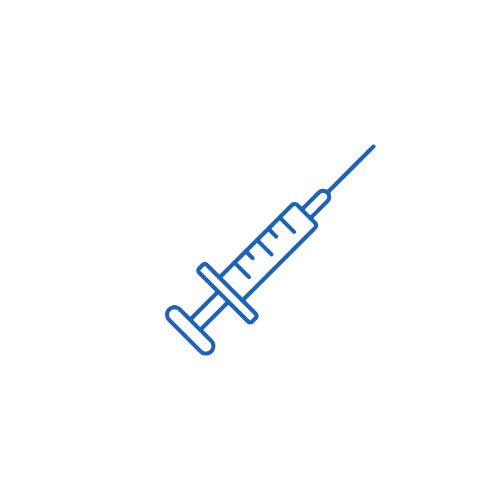Yellow Fever Vaccine
Medicines List
All MedicineIndications
Approved Uses:
- Active immunization against yellow fever virus infection in individuals aged ≥9 months, particularly:
- Travelers to endemic areas (sub-Saharan Africa and South America)
- Residents of yellow fever endemic regions
- Individuals requiring vaccination for international travel certification under the International Health Regulations (IHR)
- People at occupational risk (e.g., laboratory workers handling yellow fever virus)
Clinically Accepted Off-Label Uses:
- Emergency use during epidemics and outbreak containment
- Use in 6–8 month-old infants when the risk of exposure is high and outweighs the risk of vaccination
- Re-vaccination (booster) in immunocompromised or high-exposure individuals, although a single dose typically provides lifelong immunity
Dosage & Administration
Formulation:
- Live attenuated 17D strain
- Supplied as a lyophilized powder with diluent for reconstitution
Dose:
- 0.5 mL single subcutaneous injection
Age Group Recommendations:
- ≥9 months: Standard dose (0.5 mL SC), provides long-term immunity
- 6–8 months: Only in high-risk exposure scenarios with caution
- <6 months: Contraindicated due to risk of post-vaccine encephalitis
Booster Doses:
- Not routinely needed (WHO recommendation)
- Consider for:
- Travelers to high-risk areas if vaccinated >10 years ago and at continued exposure risk
- Individuals with HIV or other immunocompromising conditions
Administration Notes:
- Administer at least 10 days prior to travel
- Subcutaneous route preferred; intramuscular acceptable if subcutaneous is not feasible
Mechanism of Action (MOA)
The Yellow Fever Vaccine contains a live attenuated 17D strain of the yellow fever virus, which replicates locally at the injection site and in lymphoid tissues. This replication stimulates a robust immune response, producing neutralizing antibodies and activating both humoral and cellular immunity. These immune responses mimic natural infection, conferring long-lasting protection—often lifelong—against wild-type yellow fever virus upon future exposure.
Pharmacokinetics
As a live viral vaccine, traditional pharmacokinetics (absorption, distribution, metabolism, excretion) do not apply. Instead, the 17D virus:
- Replicates at the local injection site and regional lymph nodes
- Is detectable in blood within 4–6 days post-vaccination
- Peak viremia occurs around day 5–7, declining as neutralizing antibodies are produced
- Induces protective immunity typically within 10 days, with sustained antibody titers persisting for decades or lifelong in most individuals
Pregnancy Category & Lactation
Pregnancy:
- Live vaccine; generally contraindicated during pregnancy unless travel to high-risk areas is unavoidable
- If unavoidable, may be given in the second or third trimester after risk-benefit evaluation
- Some case reports suggest low risk, but caution is warranted
Lactation:
- Live virus may be secreted in breast milk
- Risk of transmitting vaccine virus to infants under 6 months
- Avoid breastfeeding for at least 2 weeks post-vaccination in such cases if alternative feeding is possible
Therapeutic Class
- Vaccine
- Subclass: Live attenuated viral vaccine
- Specific: Flavivirus vaccine
Contraindications
- Known hypersensitivity to egg proteins, gelatin, or any vaccine component
- Age <6 months
- History of thymus disease (e.g., thymoma, myasthenia gravis)
- Severe immunodeficiency (e.g., due to HIV/AIDS, chemotherapy, high-dose corticosteroids)
- Current febrile illness or acute severe infection
Warnings & Precautions
- Age >60 years: Increased risk of serious adverse events (e.g., viscerotropic disease)
- Infants 6–8 months: Increased risk of encephalitis
- Use caution in:
- HIV-positive individuals (CD4 count <200: contraindicated; 200–499: caution)
- Patients with autoimmune or thymic disorders
- Breastfeeding mothers of infants <6 months
- Monitor for signs of:
- Yellow fever vaccine-associated viscerotropic disease (YEL-AVD)
- Neurotropic disease (YEL-AND) (e.g., meningoencephalitis)
Side Effects
Common:
- Local: Pain, redness, swelling at injection site
- Systemic: Fever, headache, malaise, myalgia
Uncommon to Rare:
- Anaphylaxis
- Yellow fever vaccine-associated viscerotropic disease (YEL-AVD) – rare but potentially fatal, resembles wild-type yellow fever
- Neurotropic adverse events (YEL-AND) – meningoencephalitis, Guillain-Barré syndrome
- Hypersensitivity reactions due to egg protein or gelatin
Timing:
- Mild symptoms within 3–5 days post-vaccination
- Serious adverse events typically occur within 10 days
Drug Interactions
- Immunosuppressants (e.g., corticosteroids, chemotherapy):
- May reduce vaccine efficacy
- Increased risk of adverse events
- Other live vaccines:
- Administer simultaneously or ≥4 weeks apart
- Antiviral drugs (e.g., ribavirin):
- May impair live virus replication and thus immune response
- No known CYP450 interactions as this is a vaccine, not a drug metabolized via hepatic enzymes
Recent Updates or Guidelines
- WHO (2013): Single dose confers lifelong immunity—boosters not routinely required
- CDC (2021): Recommends booster in select individuals with ongoing exposure risk or immunocompromise
- IHR (2022): International Certificate of Vaccination valid for life, effective 10 days after vaccination
Storage Conditions
- Store at 2°C to 8°C (Refrigerated; Do not freeze)
- Protect from light
- Reconstitute with provided diluent immediately before use
- Use reconstituted vaccine within 60 minutes
- Shake gently before use
- Do not use after expiration or if vaccine appears cloudy
